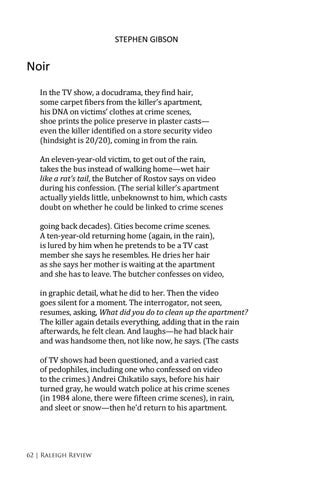STEPHEN GIBSON
Noir In the TV show, a docudrama, they find hair, some carpet fibers from the killer’s apartment, his DNA on victims’ clothes at crime scenes, shoe prints the police preserve in plaster casts— even the killer identified on a store security video (hindsight is 20/20), coming in from the rain. An eleven-year-old victim, to get out of the rain, takes the bus instead of walking home—wet hair like a rat’s tail, the Butcher of Rostov says on video during his confession. (The serial killer’s apartment actually yields little, unbeknownst to him, which casts doubt on whether he could be linked to crime scenes going back decades). Cities become crime scenes. A ten-year-old returning home (again, in the rain), is lured by him when he pretends to be a TV cast member she says he resembles. He dries her hair as she says her mother is waiting at the apartment and she has to leave. The butcher confesses on video, in graphic detail, what he did to her. Then the video goes silent for a moment. The interrogator, not seen, resumes, asking, What did you do to clean up the apartment? The killer again details everything, adding that in the rain afterwards, he felt clean. And laughs—he had black hair and was handsome then, not like now, he says. (The casts of TV shows had been questioned, and a varied cast of pedophiles, including one who confessed on video to the crimes.) Andrei Chikatilo says, before his hair turned gray, he would watch police at his crime scenes (in 1984 alone, there were fifteen crime scenes), in rain, and sleet or snow—then he’d return to his apartment.
62 | Raleigh Review


